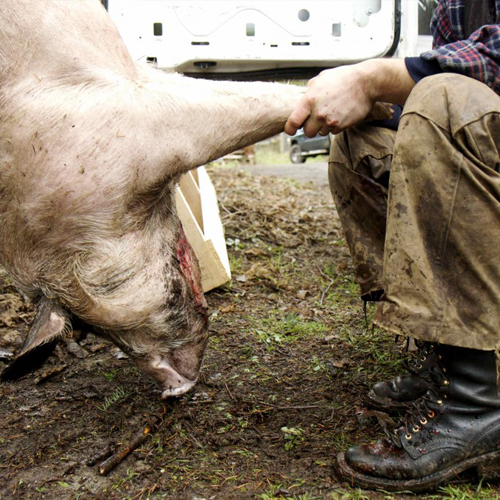

Livestock Harvesting

This is the heart of our work. We consider the entire process to be a harvest. It is not an end in itself but the means whereby food is created. It is our primary goal that this reaping harmonize with the affection, care and sacrifice that the farmer put into the sowing.
The service of slaughter, butchery and curing for small homesteads keeps Farmstead Meatsmith sharp. Each harvest is as distinct as each animal, farm and field. By harvesting this way, on the animal’s turf, we have learned the meaning of peasant economy.
Standardization and economy of scale do not fit in this economy. They are replaced by sensibility, discernment and patience. Conditioned as we have been to the promises of assembly lines, the abundance that results from a more traditional approach can be overwhelming.
We have found that not only does quality suffer in the industrial setting, but so does quantity. A peasant harvest results in more food that tastes better. Where the industry standard disposes of sometimes more than 50% of hanging weight, to say nothing of live weight, we return 100% of hanging weight to the farmer and any offal requested.
This is our work and our joy. It is our passion to bring it to you in the form of hands-on classes and educational material.
Order Forms
Each order form details the pricing of slaughter, butchery, and charcuterie. They also list all the harvesting options, from blood sausage to lamb chops. The Meatsmith Service Agreement describes how we charge for travel and other essentials to making your harvest all that it could be. Don’t hesitate to email us with questions: harvest@farmsteadmeatsmith.com.
Slaughter

Our kill methods are specific to each species. For example, pigs experience stress in a manner completely distinct from sheep and poultry. In order to avoid animal stress during the kill, these differences must be respected.
We are happy to discuss these methods with you and our reasons for following them.
The kill marks the first harvest. The hide is ready for curing. We offer to catch the blood for you and to pass-on numerous blood preparations.
The evisceration is no less a time of harvest than the butchery:
Liver, kidneys, testicles, leaf fat, caul fat, mesentery, small and large intestines, stomach, bladder, heart, lungs, tongue and brain are available to the farmer.
We also offer keeping, cooking and handling instructions for all the offal listed above.
Lamb, goat and veal hides are resources worth harvesting. We remove the hide whole and without holes for curing and tanning.
Pigs on the other hand, have skin. It is delicious. It is crackling on your pork roasts, body to braises, larding for lean cuts, flavor to the bean pot and few earthly delights surpass crispy pork rinds with PNW beer.
Therefore, we take the time to clean, scald and de-hair pigs by hand.
Butchery

We butcher to your specifications.
Electric saws have no part in our process. We prefer the knife and cleaver to ensure that meat is sliced and not shredded, thus delaying oxidization and spoilage.
We sharpen our own knives, all of which are carbon steel and therefore reusable and far from disposable.
Using these traditional tools imbues our meat carving practices with an emphasis on seam butchery, resulting in cuts better suited to the intentional kitchen and curing.
Meat carving includes wrapping for the freezer.
We help you avoid freezer burn by wrapping tightly, by hand (vacuum packers have had little success with us…they always let in air after a few weeks) and impart simple techniques enabling you to serve fresh, trussed and seasoned cuts for up to three weeks after butcher day, bypassing the freezer altogether.
Charcuterie

On butcher day, we bone-out certain cuts, then grind, mix and stuff the sausage into casings.
Any sausage recipe or style is available to the farmer. We have an arsenal of regional and traditional preparations for pork, lamb, goat, veal and poultry. It is also not uncommon to make a sausage unique to each farm, using the herbs and ingredients adjacent to the pasture.
Salami is a distillation of the life of your farm as well. The winds, molds, yeasts and sunshine that shape your farm also help to cure these dried sausages
A week after butcher day, the bacon is ready. The best bacon you will ever taste is the batch you make yourself from fresh pork and simple spices. We can also help you smoke it.
Pancetta is an Italian preparation for the same cut. Depending on the season and drying conditions, it is ready about three months after butcher day. There is no limit to the variety of meals that begin with a few bits of pancetta melting in a pan. It is the perfect example of meat functioning as a seasoning to your produce, rather than a main course.
The leg epitomizes the simultaneous simplicity and extravagance of charcuterie.
There are many styles to choose from. We can get you started on a country ham for the holidays or put a leg on the salt to be eaten raw after two years like the prosciutto crudo of Italy.
As with all charcuterie, we are available to guide you through these processes on the butcher day and long thereafter via email and telephone.
Guanciale comes from the jowl of a pig. Its uniquely dense fat distinguishes it from all other charcuterie. This makes it indispensable for pasta carbonara, or a fried egg in the morning.
Along with the other cures, guanciale functions as a seasoning. Sliced thin and eaten raw, it tastes like pork butter.
